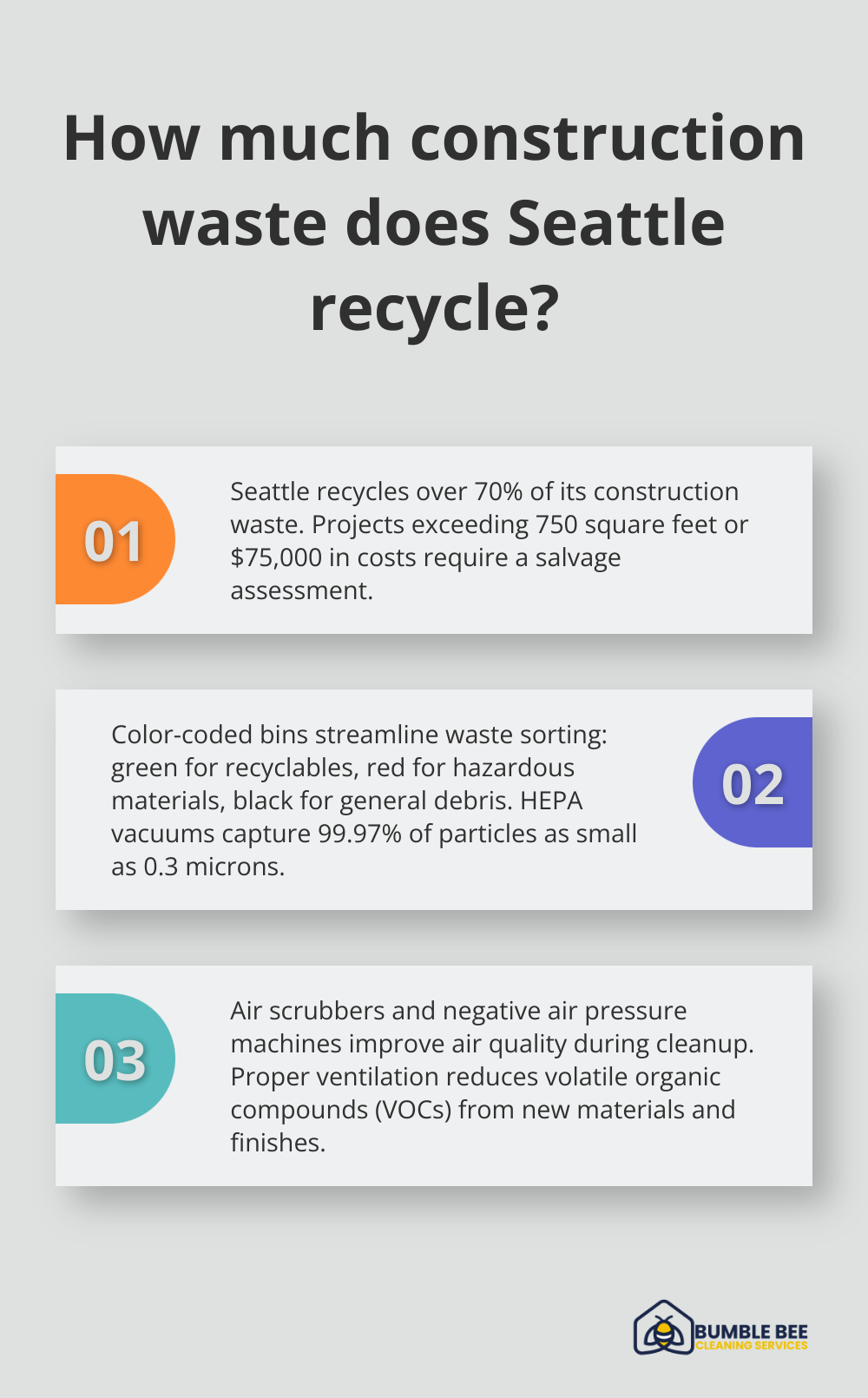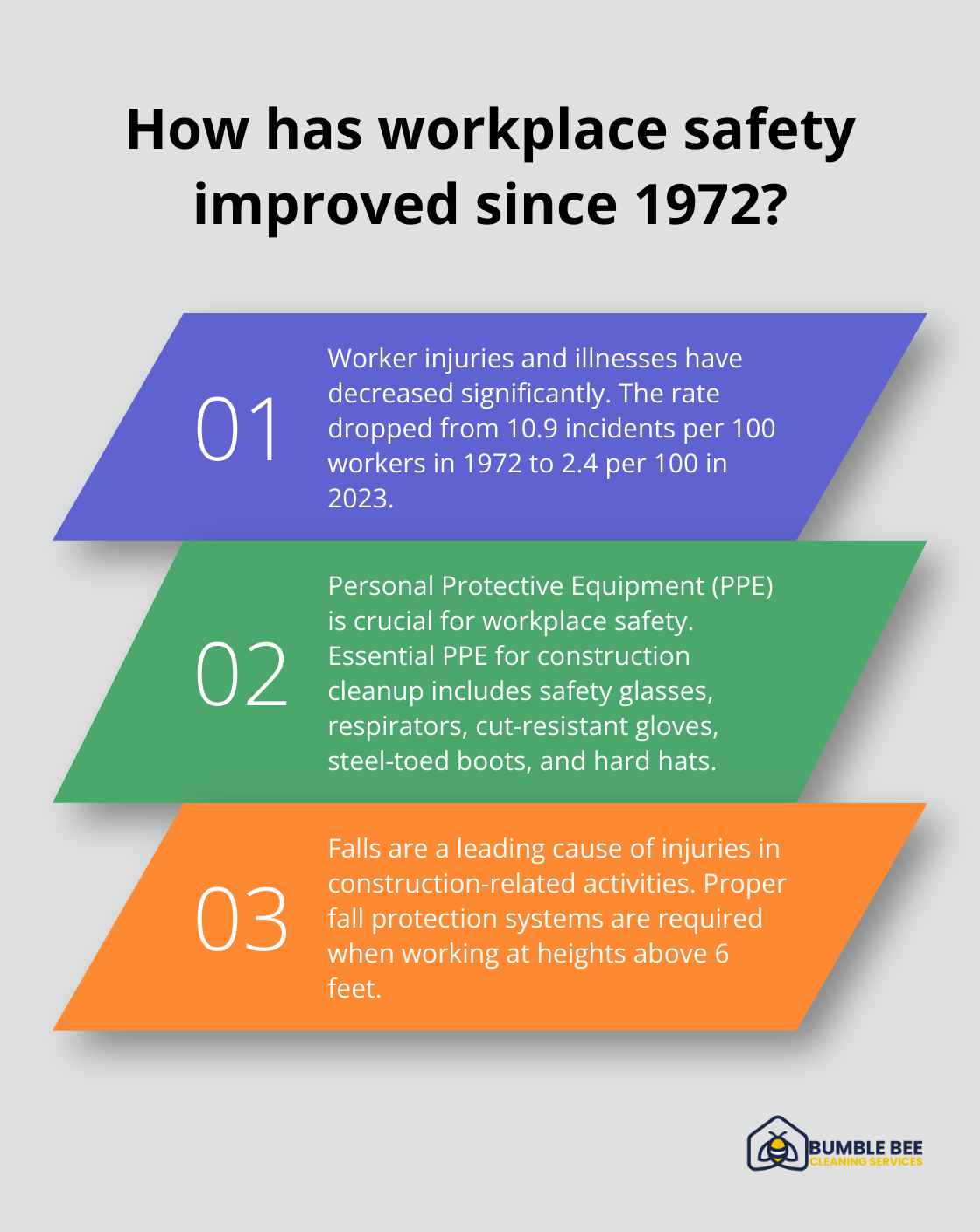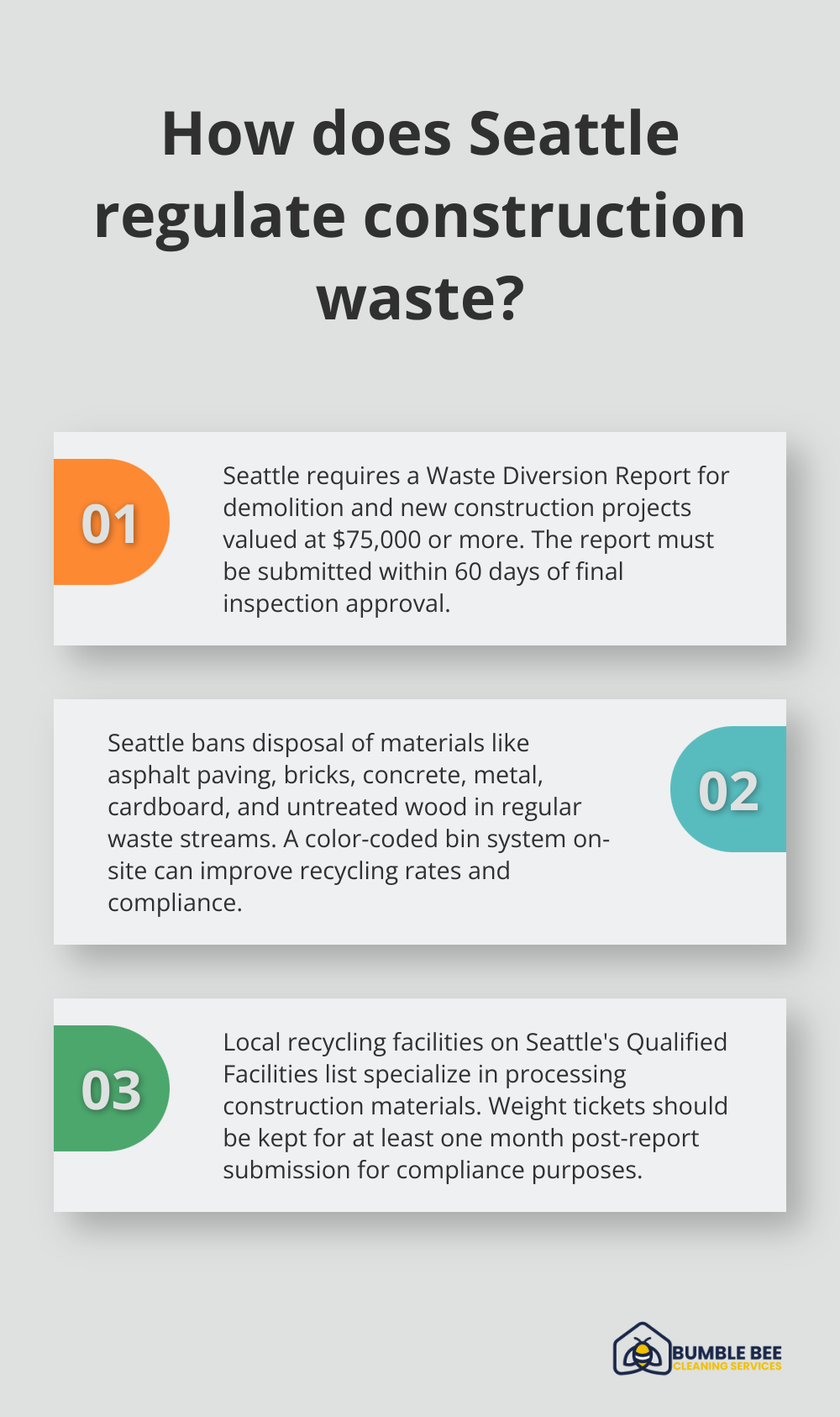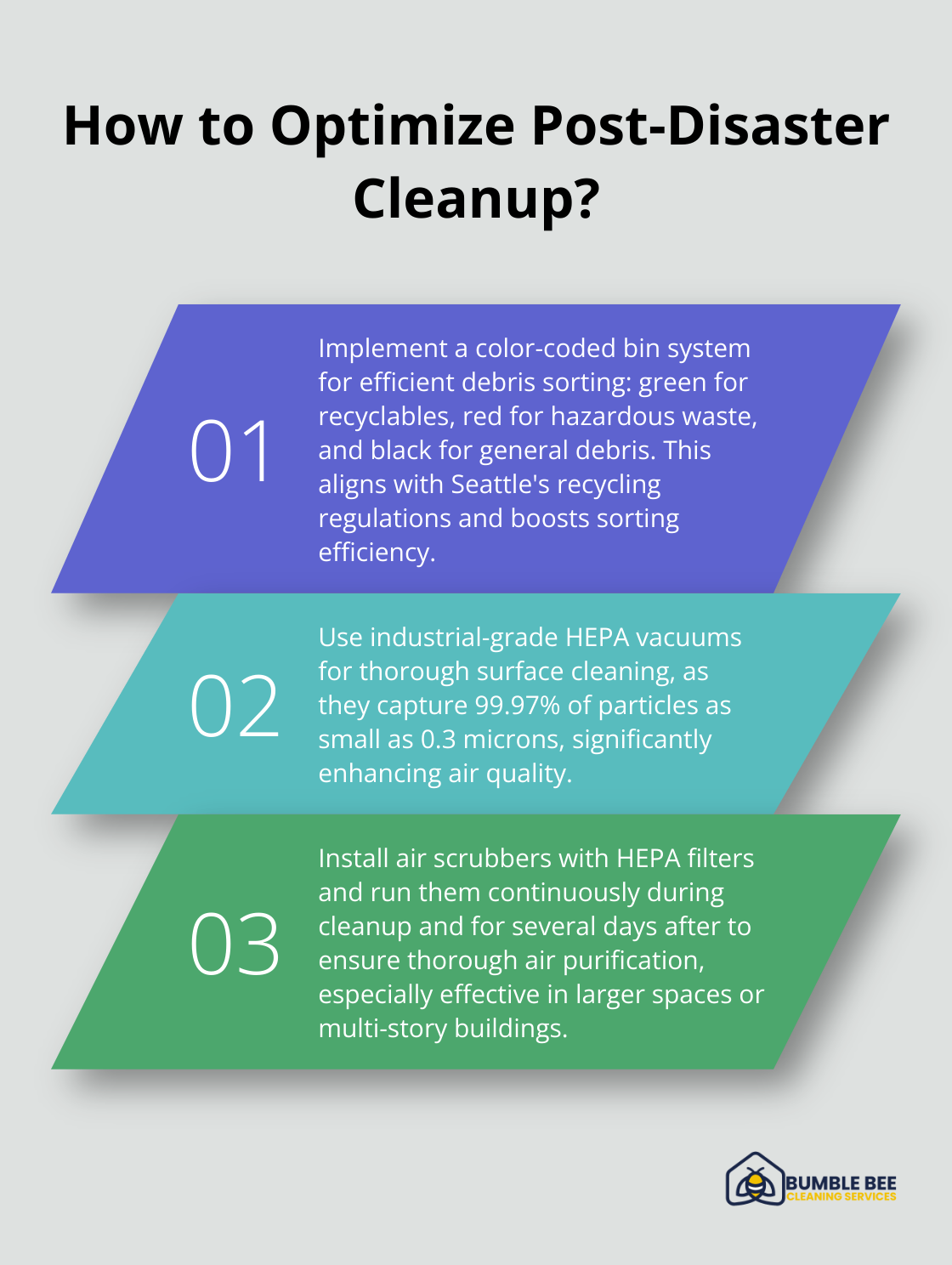Construction cleanup techniques are essential for the success of any building project in Seattle. At Bumble Bee Cleaning Services, we understand the importance of a thorough and efficient cleanup process.
This blog post will guide you through key techniques, safety measures, and eco-friendly practices to master your construction cleanup. We’ll cover everything from debris removal to air quality management, ensuring your project site is left spotless and safe.
How to Master Essential Construction Cleanup Techniques
Construction cleanup stands as a critical phase in any Seattle project. Let’s explore the essential methods that will transform your construction site into a spotless and ready-to-use space.
Efficient Debris Removal and Sorting
The first step in construction cleanup mastery involves tackling debris removal and sorting. Begin by categorizing waste into recyclables, hazardous materials, and general trash. Implement a color-coded bin system to streamline this process – green for recyclables, red for hazardous waste, and black for general debris. This system aligns with Seattle’s strict recycling regulations and can boost sorting efficiency.

For large debris, consider renting a roll-off dumpster. These containers come in various sizes. Select the appropriate size based on your project scope to minimize trips to the disposal site, thus saving time and money.
Don’t overlook salvageable materials. The Seattle Department of Construction & Inspections mandates a salvage assessment for projects exceeding 750 square feet or $75,000 in costs. Early identification of reusable items can reduce waste and potentially offset some project expenses.
Thorough Surface Cleaning and Polishing
After clearing debris, shift your focus to surface cleaning and polishing. This step reveals the true quality of your construction work. Start with a comprehensive sweep and vacuum of all surfaces using industrial-grade HEPA vacuums. These machines capture 99.97% of particles (as small as 0.3 microns), significantly enhancing air quality.
For stubborn stains on concrete or tile, employ a pressure washer. Exercise caution with the pressure setting to protect newly installed surfaces. On more delicate materials like hardwood or natural stone, opt for pH-neutral cleaners to safeguard the finish while effectively removing construction residue.
Pay attention to vertical surfaces. Walls, windows, and light fixtures often accumulate dust and grime during construction. Use microfiber cloths for dusting – they trap particles more effectively than traditional cotton cloths and can reduce bacteria counts on surfaces.
Effective Dust Control and Air Quality Management
Dust control plays a vital role in construction cleanup, especially given Seattle’s emphasis on environmental health. Implement a multi-faceted approach to manage dust and improve air quality.
Begin by sealing off cleaned areas to prevent dust migration. Use plastic sheeting and tape to create barriers between clean and in-progress areas. This simple step can cut dust spread.
Invest in air scrubbers equipped with HEPA filters. These devices remove airborne particles, including those as small as 0.3 microns. Run these continuously during the cleanup process and for several days after to ensure thorough air purification.
For larger spaces, consider negative air pressure machines. These create a vacuum effect that contains dust within the work area. They prove particularly effective in multi-story buildings or projects with sensitive adjacent spaces.
Lastly, harness the power of good ventilation. Open windows and doors when weather permits to allow fresh air circulation. This natural method significantly improves indoor air quality and reduces the concentration of volatile organic compounds (VOCs) present from new materials and finishes.
Mastering these essential cleanup techniques ensures your Seattle construction project concludes impressively. The next crucial step involves implementing proper safety measures during the cleanup process to protect workers and maintain a secure environment.
How to Prioritize Safety During Construction Cleanup
Safety stands as a cornerstone of effective construction cleanup. At Bumble Bee Cleaning Services, we understand the critical importance of robust safety protocols during post-construction cleanup operations.
Essential Personal Protective Equipment
Personal Protective Equipment (PPE) serves as the primary defense against workplace hazards. Worker injuries and illnesses are down-from 10.9 incidents per 100 workers in 1972 to 2.4 per 100 in 2023-due to proper PPE use.

For construction cleanup, essential PPE includes:
- Safety glasses or goggles
- Respirators or dust masks
- Cut-resistant gloves
- Steel-toed boots
- Hard hats
Train all team members in the correct use and maintenance of their PPE. Conduct regular inspections of equipment condition to maintain optimal protection.
Safe Handling of Hazardous Materials
Construction sites often contain hazardous materials that require special handling during cleanup. The Environmental Protection Agency (EPA) stresses the importance of proper identification, containment, and disposal of these substances.
Key steps for safe hazardous material handling include:
- Conduct a thorough site assessment
- Use appropriate containment methods
- Follow local regulations for disposal
- Provide specialized training for team members
- Maintain a well-stocked spill kit on-site
Preventing Falls and Ensuring Ladder Safety
Falls remain a leading cause of injuries in construction-related activities.
To mitigate fall risks:
- Use proper fall protection systems when working at heights above 6 feet
- Ensure all ladders are in good condition and set up correctly
- Follow the “three-point contact” rule when climbing ladders
- Keep work areas clear of trip hazards
- Use guardrails or safety nets where appropriate
For ladder safety specifically:
- Choose the right ladder for the job (based on height and weight capacity)
- Inspect ladders before each use
- Set up ladders on stable, level surfaces
- Maintain a 4:1 ratio for extension ladders
- Never stand on the top rung or step of a ladder
Dust Control for Respiratory Protection
Effective dust control protects respiratory health during construction cleanup. The EPA highlights that indoor air pollutant concentrations can significantly affect air quality, particularly in newly constructed spaces.
To minimize respiratory risks:
- Use wet methods for dust suppression when possible
- Employ HEPA vacuums for dust collection
- Establish negative air pressure in work areas
- Provide proper respiratory protection based on dust exposure levels
- Conduct regular air quality monitoring
Implementing these safety measures not only protects workers but also ensures compliance with local and federal regulations. The Seattle Department of Construction & Inspections conducts regular safety inspections, making adherence to these practices essential for avoiding penalties and maintaining project timelines.
As we shift our focus to eco-friendly cleanup practices, it’s important to note that safety and sustainability often go hand in hand. The next section will explore how to incorporate green cleaning methods into your Seattle construction project, further enhancing both worker safety and environmental stewardship.
How Seattle Projects Can Embrace Eco-Friendly Cleanup
The Power of Green Cleaning Products
Seattle’s commitment to sustainability extends to construction cleanup practices. Eco-friendly cleanup aligns with the city’s environmental goals and offers tangible benefits for project managers and property owners.

Green cleaning products have evolved significantly in recent years. These eco-friendly alternatives now match the effectiveness of traditional products without the harmful environmental impact. The use of biodegradable cleaning agents leads to a decrease in the environmental footprint of post-construction cleanup.
When selecting green cleaning products for your Seattle project, choose those certified by Green Seal or EcoLogo. These certifications ensure products meet strict environmental standards. Low-VOC (Volatile Organic Compound) cleaners improve indoor air quality and reduce health risks for workers and future occupants.
Microfiber cloths and mops serve as another eco-friendly tool. They require less water and fewer cleaning agents while trapping dust and debris more effectively. Studies show that microfiber cloths reduce bacteria counts on surfaces more effectively than traditional cotton cloths.
Waste Segregation and Recycling Efforts
Proper waste segregation plays a key role in effective recycling and waste reduction. Seattle requires a Waste Diversion Report for all demolition projects and new construction valued at $75,000 or more (submission within 60 days of final inspection approval).
To streamline your waste segregation process, use a color-coded bin system on-site. Designate specific containers for different materials such as wood, metal, concrete, and plastics. This system improves recycling rates and helps comply with Seattle’s ban on disposing of materials like asphalt paving, bricks, concrete, metal, cardboard, and untreated wood in regular waste streams.
Work with local recycling facilities listed on Seattle’s Qualified Facilities list. These facilities specialize in processing construction materials, ensuring responsible waste handling. Keep weight tickets for at least one month post-report submission for compliance purposes.
Water Conservation Techniques
Water conservation forms a critical aspect of eco-friendly cleanup, especially given Seattle’s focus on protecting its water resources. Use high-pressure, low-flow cleaning equipment. These tools deliver effective cleaning power while reducing water usage significantly.
Capture and reuse water where possible. When pressure washing surfaces, set up a water reclamation system to collect and filter the runoff. This water can then serve other cleaning tasks or dust suppression.
Try dry cleaning methods for certain tasks. Techniques like dry ice blasting clean surfaces effectively without using water, making them ideal for areas where water use needs minimization.
Eco-Friendly Dust Control Methods
Dust control protects both worker health and the environment. Use wet methods for dust suppression when possible, but be mindful of water conservation. HEPA vacuums effectively collect dust without spreading it into the air.
Establish negative air pressure in work areas to contain dust and prevent it from migrating to clean spaces. This method proves particularly effective in multi-story buildings or projects with sensitive adjacent areas.
Harness the power of natural ventilation. Open windows and doors when weather permits to allow fresh air circulation. This method improves indoor air quality and reduces the concentration of volatile organic compounds (VOCs) present from new materials and finishes.
Final Thoughts
Construction cleanup techniques are essential for successful Seattle projects. Efficient debris removal, thorough surface cleaning, and effective dust control create spotless and safe work environments. Proper safety measures protect workers and maintain compliance with local regulations. Eco-friendly cleanup practices align with Seattle’s sustainability commitment and contribute to improved indoor air quality and resource efficiency.

Safety and environmental considerations work together during construction cleanup. Project managers who prioritize both aspects create healthier workspaces, comply with regulations, and contribute to Seattle’s sustainability goals. These practices benefit the immediate project and have long-lasting positive effects on the community and environment.
Bumble Bee Cleaning Services offers comprehensive solutions for construction cleanup in Seattle. Our team (certified by ARCSI, IICRC, and OMWBE) specializes in post-construction cleaning with eco-friendly products. We provide exceptional customer service with a 100% quality guarantee, flat-rate pricing, and easy online booking.
